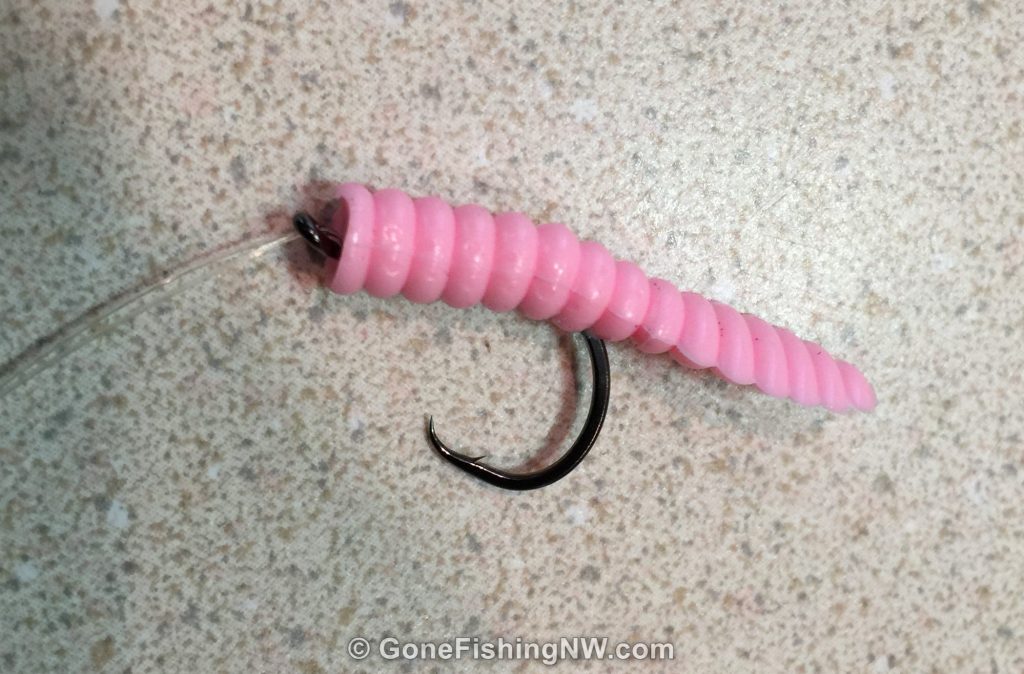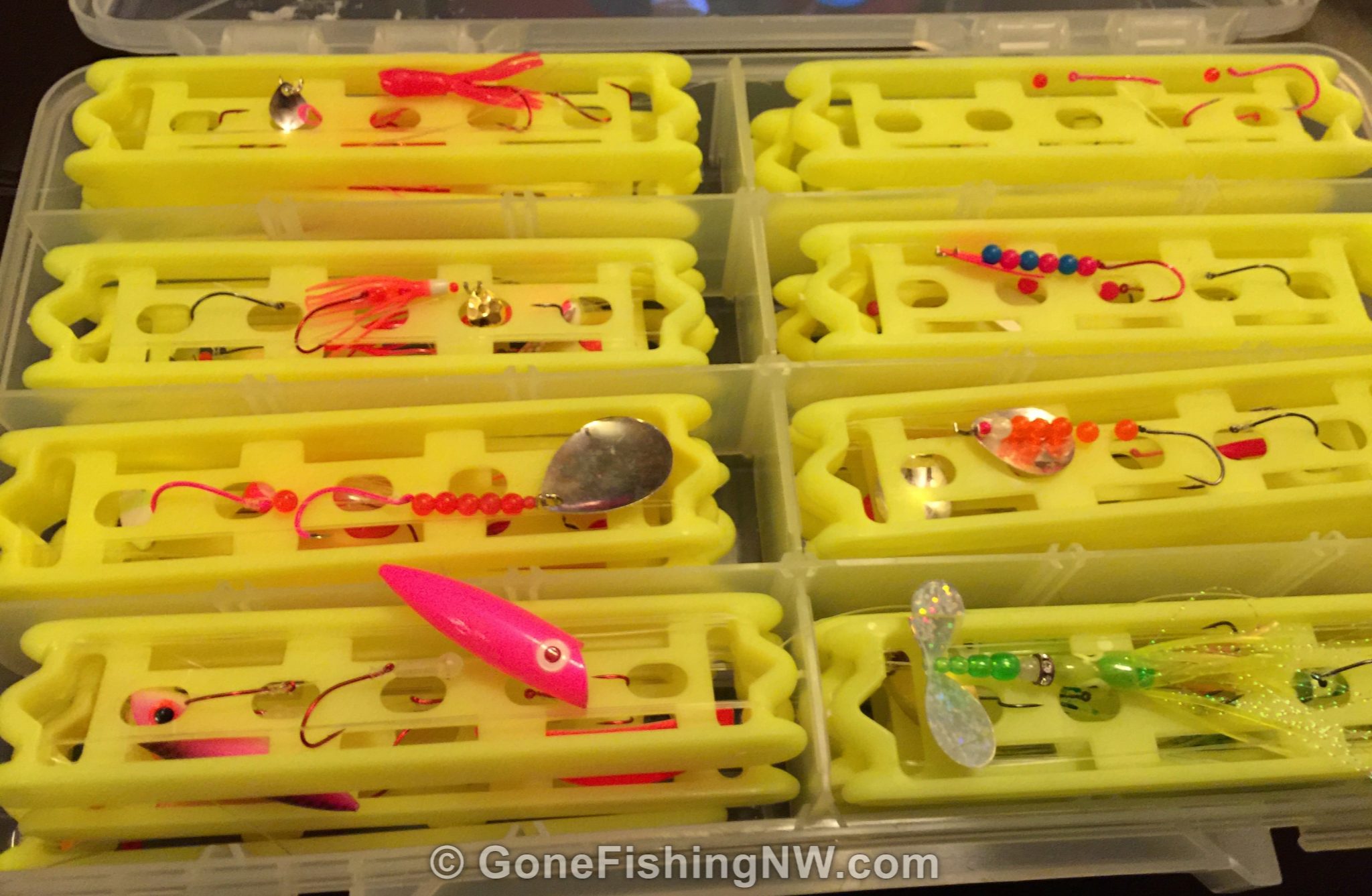During the winter months I tend to fish mostly for perch. I like how simple and relaxing it is. Plus it is great fishing to take kids and new fishermen too – plenty of action to keep them entertained, and lets them learn the basics of working a rod and reel, setting the hook, and other basic fishing skills.
I’ve written a long article – How To Catch Perch By The Hundreds – which covers generally how to fish for perch in pretty much every location and time of year.
This article, however, will focus on fishing in winter months in our western Washington waters – namely Lake Washington.
Preparing for Success
The first thing to do is to prepare your gear before you leave the house. Perch are small fish, and they don’t fight very hard. So light tackle is all you need. I use my ultralight trout rods, and they work out great. Specifically that is a 6 foot ultra light Diawa Spinmatic, paired with a Pflueger President reel (which I think is the best spinning reel in the under $100 price range). The reel is spooled up with braided line (my favorite being Power Pro Depth Hunter). Braid is nice for this because the perch are going to be in the deeper water, so the lack of stretch will help detect bites and set the hook.

Other than the rod and reel, we need the terminal tackle. Some people swear by buzz bombs, Swedish Pimples, Kastmasters or curly tail jigs. All those work great, but I prefer to keep it simple with a bait and weight rig – specifically a drop shot rig.
Tying a Perch Drop Shot Rig
The perch drop shot rig boils down to a weight on the end of the line, with a hook tied some distance above. However there are a couple of things I tweak on this to maximize my odds for this winter perch fishery.
First I take light line, such as 6 pound Maxima Ultragreen, and cut about a 4 foot length.
I pick one end to be the “bottom” and about 8 inches from that I’ll tie a surgeon’s loop knot. I make the loop a little bit longer than the hook. I then go “up” about 3 or 4 inches and tie another one. Then again, another 3 or 4 inches. I’m then left with 3 loops – each a bit larger than the hooks – about 3 inches apart.
Next I tie a weight onto the bottom end, about 3 inches from the most bottom loop, and trim the tag end. I like using cannonball weights. Given the depths we’ll be fishing use at least 1oz. However, a heavier weight, up to 2oz, can be useful – especially when drifting fast or with novice fishermen.
Now I’ll take 3 hooks. These can be size 6 or 8 hooks. I use either octopus hooks or drop shot hooks. I’ll then take one of the loops and feed it through the eye of a hook. Then pull the loop over the hook and pull it tight. If the loop is hard to get through the eye, then I’ll use an extra piece of line to help pull it through.
Once all 3 hooks are fastened, I’ll then tie the top of the rig to my mainline. You are then good to go. The hooks can be baited with pieces of night crawlers or pieces of perch fillets.
Keep It Warm and Fun
Now this is winter fishing, and so we need to plan accordingly. Nothing takes the fun out of fishing – especially for kids – than being cold and hungry. And on a boat if the kids aren’t having fun, no one is having fun.
So, make sure everyone dresses warm, with multiple layers. It is always easy to remove layers if one is too hot. Most heat loss occurs through the head, so stocking caps or similar are also recommended.
When fishing with kids I always try to bring along plenty of snacks – fruit snacks, granola bars, cookies, etc.. A good fishing buddy of mine would always have a few chocolate bars on hand. He believed that a small sugar rush can help warm you up and keep you going. Consider some hot chocolate or other warm beverage in a thermos.
Consider bringing a small heater for the boat. It doesn’t take much to warm a small enclosed space. Remember to have proper ventilation.
Location, Location, Location
Once you are on the water you need to find a good spot. The worst thing you can do is fish randomly in areas which aren’t producing.
During the winter months the fish are going to be in the deeper water (60-90 feet deep). Look for areas which are that deep, but are reasonably close to the shallower water where they will be when the water warms up.
Use your fish finder to scout before you drop a line in the water. The perch will look like little bumps or rocks on bottom. Occasionally you’ll see a cluster or them, or a couple suspended a couple feet above the bottom. If you aren’t seeing fish on the finder then move on.
Once you start fishing, pay attention to how well people in the boat are doing. If the bites die off or the area isn’t productive then move on.

The nice thing is that there are probably millions of perch in Lake Washington. So there isn’t the one “spot”, instead there are many good “spots” in the lake. When you find one, mark it on your GPS – because the perch will be there again.
How To Fish
Once you find a good spot, it is time to bait up your hooks. I like starting with a piece of nightcrawler on the hook. In a pinch, however, artificial baits like Gulp Maggots will work. I’ve even caught them on a piece of yarn, and a friend has gotten them on artificial flies.
Once you get a few fish to the boat it is best to fillet one out and use small pieces of the fillet as bait.
Whatever the bait you use, make sure to cut it so it is only a little bit longer than the hook. We are trying to get them to bite – not give them an all you can eat buffet.
Once baited, put your line in the water and let it sink to the bottom. This can take a while in deep water. This is where a heavy weight is nice, as not only does it sink quicker but it is more obvious when it reaches bottom.
Once on bottom, remove the slack from the line and wait.
Occasionally pulling it up a couple feet and letting it drop back down and hit bottom is okay. This will kick up some silt, and attract nearby perch. However, the perch will tend to bite when your bait is stationary – so don’t move it around very much
Detecting the Bite
The bite is typically some short, quick tugs – almost like they are nibbling at the bait.
When that happens, you need to set the hook. If you do a Bass Master style big hookset, then odds are you just ripped the hook out of the fish’s mouth. So instead you want to raise the rod in a firm, deliberate manner, not a quick jerk.
Once they are hooked, keep steady pressure on while reeling in the fish. Introducing slack in the line may cause the fish to come unhooked.
If you missed the fish, or if it came off while reeling, then I typically drop it right back down. The bait tends to stay on the hook – especially if using perch pieces. Of course, if you go a few minutes without a bite after that you may want to bring it all the way in to do a bait check.
Nice and Slow Drift
I’ve fished for perch both while anchored and drifting. I believe that drifting is the better method. It will expose your bait to more fish, and I believe the movement helps make the bait seem more alive.
The key is getting the right speed to the drift. That right speed is between 0.1-0.3 MPH. Ideally there is just enough wind blowing to keep you in that range.
When you finally drift out of the “spot” then reel everything in and use the motor to re-position the boat to do the drift again.
Dealing with No Wind
If there is no wind, then you can use the motor to move the boat. This is easy with an electric motor which gives you fine tune speed control.
Gas kicker motors, on the other hand, typically are hard to achieve such low speeds. So instead I’d recommend putting the motor in gear for a while, then taking it out of gear for a couple minutes. This start and top is better than sitting completely still.
Dealing With Too Much Wind
The most common problem I have is too much wind, and so far I don’t have a really great way to deal with it. The motor can be used to slow the boat down, or even slowly “drift” into the wind. However, it doesn’t take much for the boat to catch the wind and suddenly turn to one side. This makes it hard to steer and fish at the same time.
The best solution I’ve found so far is to deploy drift socks. Those can help slow down the boat, and don’t need one to constantly try to control it.
Another trick I’ve used if the boat is drifting too fast is this:
- Let the line out until it hits bottom like normal.
- Close the bail on the reel, but don’t take up the slack. Instead wait for the boat movement to remove the slack.
- After about 10 seconds, open the bail back up and count off 5 seconds.
- Close the bail.
Usually I’ll get a bite shortly after closing the bail. I’ll repeat opening and closing the bail until I get a fish or have too much line out. Either way I’ll reel it all the way back in and start over.
This technique is more successful if you are using heaver weights. Yet another reason to use close to 2oz weights.
Questions?
What tips and tricks do you use to get lots of perch? How do you deal with the wind?
Please let me know and share your perch fishing experiences. Tight Lines!












Comments are closed.